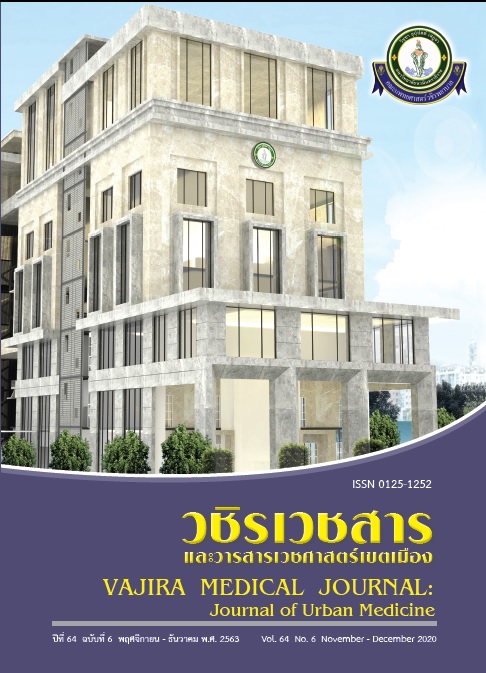Prevalence and Risk Factors of Osteopenia of Prematurity of Very Low Birth Weight Infants at Faculty of Medicine Vajira Hospital
Main Article Content
Abstract
Background: The advanced neonatal care improved survival of preterm and very low birth weight (VLBW) infants. However, complications of prematurity increased especially osteopenia of prematurity which caused long-term effects to these infants.
Objective: To determine prevalence and risk factors of osteopenia of prematurity in VLBW infants.
Methods: Retrospective descriptive study was conducted at Vajira Hospital. Medical records and x-rays of infants, whose birth weight was less than 1,500 grams and admitted more than 8 weeks from January 2014 to May 2019, were reviewed.
Results: Eighty VLBW infants were enrolled. Prevalence of osteopenia of prematurity in VLBW infants was 12.5%. Factors associated with osteopenia of prematurity were long duration of nothing per oral, long duration to full enteral feeding, necrotizing enterocolitis (NEC), duration of total parenteral nutrition, duration of use medication (furosemide, aminophylline) and length of hospital stay. After using logistic regression analysis, only three factors including NPO time, duration to full enteral feeding and the presence of NEC were significant. The presence of NEC was the most related risk factor (OR 12.40, 95% CI 1.81-84.77). Infants with osteopenia received less energy, calcium and phosphorus than those without osteopenia.
Conclusions: The prevalence of osteopenia of prematurity in VLBW infants at Faculty of Medicine Vajira Hospital was 12.5%. Factors associated with osteopenia of prematurity were long duration of nothing per oral, long duration to full enteral feeding and presence of NEC.
Downloads
Article Details
References
Rehman MU, Narchi H. Metabolic bone disease in the preterm infant: Current state and future directions. World J Methodol 2015;5:115-21.
Kulkaini PB, Hall RT, Rhodes PG, Sheehan MB, Callenbach JC, Germann DR, et al. Rickets in very low-birth-weight infants. J Pediatr 1980;96:249-52.
Wattanasereewong W. Prevalenceand risk factors of rickets of prematurity at Siriraj Hospital. [internet]. 2004 [cited 2017 Jun 15]. Available from: http://www.medlib.si.mahidol.ac.th/siriraj/
McIntosh N, Livesey A, Brooke OG. Plasma 25-hydroxyvitamin D and rickets in infants of extremely low birthweight. Arch Dis Child 1982;57:848-50.
Ukarapong S, Venkatarayappa SKB, Navarrete C, Berkovitz G. Risk factors of metabolic bone disease of prematurity. Early Hum Dev 2017;112:29–34.
Lee SM, Namgung R, Park MS, Eun HS, Park KI, Lee C. High incidence of rickets in extremely low birth weight infants with severe parenteral nutrition-associated cholestasis and bronchopulmonary dysplasia. J Korean Med Sci 2012;27:1552–5.
Tinnion RJ, Embleton ND. How to use alkaline phosphatase in neonatology. Arch Dis Child Educ Pract Ed 2012;97:157-63.
Mazess AB, Peppler WW, Chesney RW, Lange TA, Lindgren U, Smith E. Does bone measurement on the radius indicate skeletal status? J Nucl Med 1984;25:281-8.
Abdallah EAA, Said RN, Mosallam DS, Moawad EMI, Kamal NM, Fathallah MGED. Serial serum alkaline phosphatase as an early biomarker for osteopenia of prematurity. Medicine 2016;95:e4837.
Rustico SE, Calabria AC, Garber SJ. Metabolic bone disease of prematurity. J Clin Transl Endocrinol 2014;1:85–91.
Bozzetti V, Tagliabue P. Metabolic bone disease in preterm newborn: An update on nutritional issues. Ital J Pediatr 2009;35:14-20.
Glasgow JFT, Thomas PS. Rachitic respiratory distress in small preterm infants. Arch Dis Child 1977;52:268-73.


